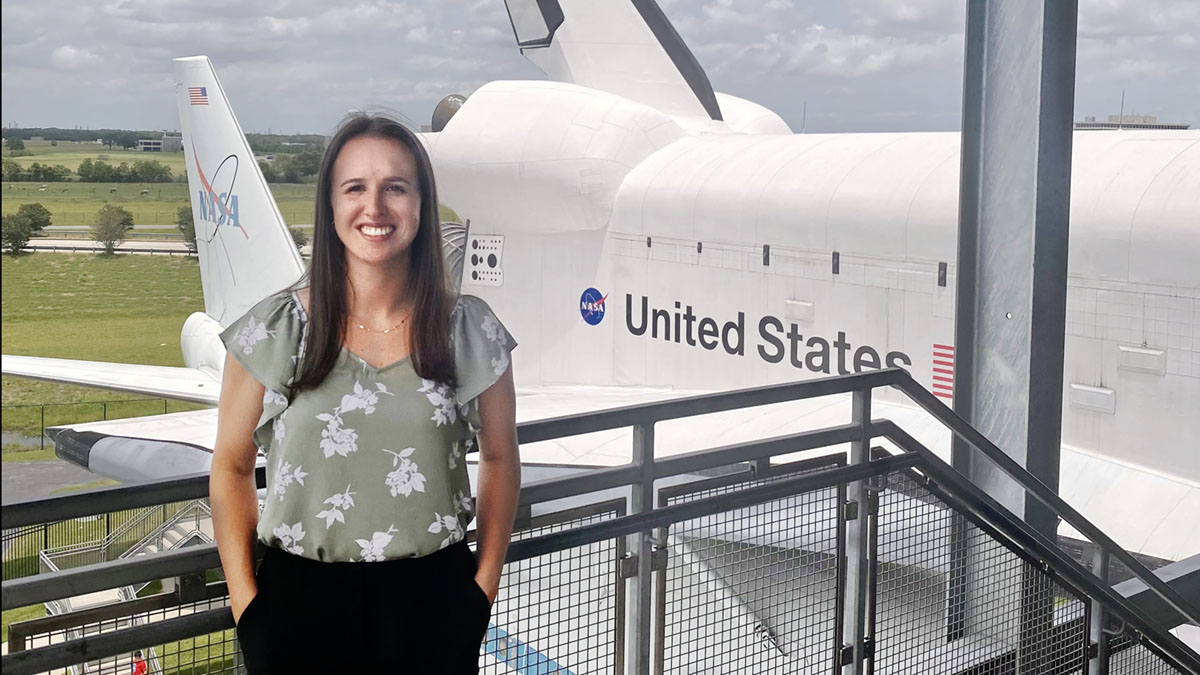Wearable tech to keep astronauts healthier
Ally Rice is working with NASA to create wearables that keep astronauts fit for extended journeys.

Ally Rice’s summer took her to mission control and massive rocket ships. It brought her face-to-face with astronaut training, the International Space Station and NASA scientists.
During her time at NASA’s Johnson Space Center as part of a fellowship, it began to set in: Her research at Ohio State may one day reach space.
“Visiting NASA, it was like, whoa, this is real,” says Rice, a PhD student in electrical and computer engineering. “It reminds you how significant the NASA mission is, sending people to the moon, to Mars.
“Feeling the excitement there, hearing from their experts, it left me inspired. It made me feel like what I’m doing may have an actual impact in the future.”
Under the guidance of Ohio State’s Asimina Kiourti, Rice is developing wearable technology that could help astronauts travel in space longer.
Long periods in zero gravity can lead to dangerous health problems, such as muscle atrophy, decreased bone density and fluid shifting throughout the body, among other issues.
“A trip to Mars is six months, we’re talking about putting colonies on the moon, what are the effects going to be?” says Michael Khayat, Rice’s NASA collaborator who specializes in applied electromagnetics. “It’s an extraordinarily complicated problem we’re trying to solve.”
As a student in Kiourti’s Wearable and Implantable Technologies lab, Rice was awarded her NASA fellowship a year ago to develop wearable antennas that will closely monitor astronauts’ physiology during space travel. It’s an idea that builds off previous work in Kiourti’s lab, using “biomatched” antennas to see inside our bodies.

When Rice first began working on the antenna, she and Kiourti were trying to develop novel applications for it. That’s when they saw the NASA fellowship opportunity. They then came up with a “visionary” idea, according to Kiourti, to create a sleeve or garment to monitor astronaut physiology during space travel. The more astronauts understand what’s happening to their bodies, the more they can adjust through exercise or diet.
“(Kiourti) is incredible at helping us see the big picture, brainstorm and sell our ideas,” Rice says. “One of the reasons I came to Ohio State was because I saw what she was doing, these very interesting applications of technology. She’s always coming up with new ideas and inspiring us to work harder because of all her accomplishments.”
While work on the wearable technology is a four-year, year-round project, the fellowship also includes internships to NASA centers, such as Rice’s summer stay in Houston, to work directly with NASA scientists in the human research program. Khayat says Rice’s work will go a long way in bolstering ongoing research.
“The benefit we’ll get from her work is exciting,” Khayat says. “She’s already made quite a bit of progress on the antennae design — it’s really slick. Now it’s getting it to interact with the human body. What we learn from her research will be incredibly important.”
Kiourti and Rice also see possible applications back home, including bone loss caused by osteoporosis, cancer detection, tumor classification and core temperature image capture to ensure safer operations.
These experimental and novel approaches to wearable technology applications are a hallmark of Kiourti’s lab because she works closely with researchers from other disciplines – like health care – and other industries – from fashion to NASA.
“These real-world collaborations have been such a great experience. It’s made what I’m doing feel more relevant,” Rice says. “I never expected when I came to Ohio State that I’d be working closely with NASA but it’s been incredible.”